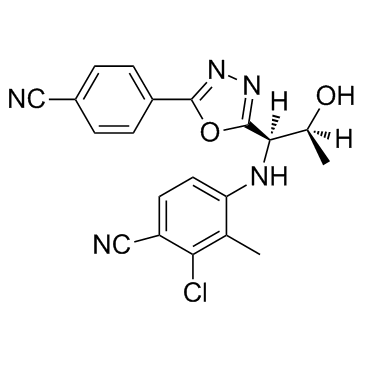RAD140
Modify Date: 2024-01-02 14:37:36

RAD140 structure
|
Common Name | RAD140 | ||
|---|---|---|---|---|
| CAS Number | 1182367-47-0 | Molecular Weight | 393.826 | |
| Density | 1.4±0.1 g/cm3 | Boiling Point | 687.7±65.0 °C at 760 mmHg | |
| Molecular Formula | C20H16ClN5O2 | Melting Point | N/A | |
| MSDS | N/A | Flash Point | 369.7±34.3 °C | |
Use of RAD140RAD140 is a potent, orally bioavailable, nonsteroidal selective androgen receptor modulator (SARM). IC50 value: 7 nM (Ki, fot androgen receptor) [1]Target: androgen receptor in vitro: RAD140 demonstrates excellent affinity for the androgen receptor (Ki = 7 nM) as well as good selectivity over other steroid hormone nuclear receptors, with the closest off target receptor being the progesterone receptor (IC50 = 750 nM). [1] RAD140 is a novel SARM with high affinity and specificity for AR, is orally available, and exhibits potent anabolic effects in rodents and nonhuman primates.[2]in vivo: The stability of RAD140 is high (t1/2 > 2 h) in incubations with rat, monkey, and human microsomes, and it also had good bioavailability in rats and monkeys. [1] RAD140 is also neuroprotective using the rat kainate lesion model. RAD140 is shown to exhibit peripheral tissue-specific androgen action that largely spared prostate, neural efficacy by activation of androgenic gene regulation effects, and neuroprotection of hippocampal neurons against cell death caused by systemic administration of the excitotoxin kainate.[2] |
| Name | 2-chloro-4-[[(1R,2S)-1-[5-(4-cyanophenyl)-1,3,4-oxadiazol-2-yl]-2-hydroxypropyl]amino]-3-methylbenzonitrile |
|---|---|
| Synonym | More Synonyms |
| Description | RAD140 is a potent, orally bioavailable, nonsteroidal selective androgen receptor modulator (SARM). IC50 value: 7 nM (Ki, fot androgen receptor) [1]Target: androgen receptor in vitro: RAD140 demonstrates excellent affinity for the androgen receptor (Ki = 7 nM) as well as good selectivity over other steroid hormone nuclear receptors, with the closest off target receptor being the progesterone receptor (IC50 = 750 nM). [1] RAD140 is a novel SARM with high affinity and specificity for AR, is orally available, and exhibits potent anabolic effects in rodents and nonhuman primates.[2]in vivo: The stability of RAD140 is high (t1/2 > 2 h) in incubations with rat, monkey, and human microsomes, and it also had good bioavailability in rats and monkeys. [1] RAD140 is also neuroprotective using the rat kainate lesion model. RAD140 is shown to exhibit peripheral tissue-specific androgen action that largely spared prostate, neural efficacy by activation of androgenic gene regulation effects, and neuroprotection of hippocampal neurons against cell death caused by systemic administration of the excitotoxin kainate.[2] |
|---|---|
| Related Catalog | |
| References |
| Density | 1.4±0.1 g/cm3 |
|---|---|
| Boiling Point | 687.7±65.0 °C at 760 mmHg |
| Molecular Formula | C20H16ClN5O2 |
| Molecular Weight | 393.826 |
| Flash Point | 369.7±34.3 °C |
| Exact Mass | 393.099243 |
| PSA | 118.76000 |
| LogP | 3.02 |
| Vapour Pressure | 0.0±2.3 mmHg at 25°C |
| Index of Refraction | 1.652 |
| Storage condition | -20℃ |
| 2-Chloro-4-({(1R,2S)-1-[5-(4-cyanophenyl)-1,3,4-oxadiazol-2-yl]-2-hydroxypropyl}amino)-3-methylbenzonitrile |
| rad140 |
| Benzonitrile, 2-chloro-4-[[(1R,2S)-1-[5-(4-cyanophenyl)-1,3,4-oxadiazol-2-yl]-2-hydroxypropyl]amino]-3-methyl- |
| RAD-140 |